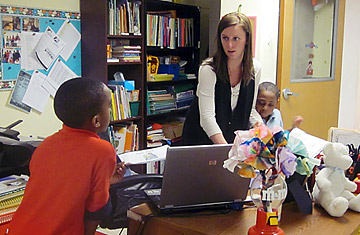
Holly Haralson, a teacher at the Lighthouse Academy in Akron, Ohio, works with first- and second-grade students on Nov. 29, 2011
Terri Griffin made herself a promise when her youngest daughter was ready for kindergarten: the little girl would never set foot in an Akron public school. Griffin, a jewelry-store clerk and graduate of the Ohio city's school system, had sent eight children — two of her own and six others she raised as her own — to traditional public schools.
She felt they were pushed through to a diploma and didn't learn enough. Teachers were eager to recommend special education, but Griffin couldn't get them to provide other, basic help. So for her youngest daughter, she sought out a charter school, Lighthouse Academy, and hoped for a better outcome.
Griffin didn't know about Lighthouse Academy's low test scores or that it had been identified by the state as being in an academic emergency on and off since opening in 2000. Instead, when she visited the west Akron school, Griffin saw caring teachers working with small classes in a school that was well established in the community. She hasn't once regretted her decision.
Now, under Ohio's charter school closure law, considered the toughest in the nation, Lighthouse Academy is slated to be shuttered at the end of the year. The 2006 law mandates that any charter school that has received the state's Academic Emergency rating or been placed on academic watch for two out of three years will be shut down. (The ratings are based on state test scores.)
Most of Lighthouse's 66 students will be thrust back into the same public schools their parents tried to flee. Nearby public schools perform only slightly better than Lighthouse on standardized tests, and some do just as poorly.
The closure is another blow for the children of this fading industrial city, where a third of all kids live in poverty and about a quarter of high schoolers fail to graduate. It's a scenario becoming familiar to thousands of families in the nation's poorest neighborhoods as more and more districts start cracking down on low-performing charter schools, which get public funds but operate without the usual bureaucratic constraints.
The dismantling of so many charters has some experts worrying that when students are forced to leave educational environments where they have friends and feel comfortable, the disruption is destabilizing and upsetting to some of the system's most vulnerable populations. Robert Slavin, director of the Center for Research and Reform in Education at Johns Hopkins University in Maryland, believes closure should be a last resort, after giving schools support and experimenting with possible solutions. Otherwise, well-meaning educational programs could wind up hurting the very kids they are trying to help. "Letting alone or closing are not the only two options," Slavin says. "[Closing] is very damaging to kids."
Nonetheless, the crackdown on ineffective charter schools has the backing of charter supporters as well as critics. In an effort to save the charter movement, which has come under increasing scrutiny, advocates have asked for more accountability, supporting forced closures of low-performing schools. Florida has already adopted a law similar to Ohio's. During the current legislative session, charter advocates in Missouri are pushing a bill that would require charter schools to set up specific benchmarks, giving sponsors an easy way to hold schools accountable. The California Charter Schools Association has said it will start urging school boards to not allow faltering schools to stay open.
Bill Sims, president of the Ohio Alliance of Public Charter Schools, says he regularly gets calls from his counterparts in other states asking for more information on Ohio's law so they can use it as a model for their own legislation.
"The good news is, Ohio doesn't keep underperforming schools open. The bad news is, it hit Lighthouse," says Marianne Cooper, director of the Richland Academy of the Arts, the nonprofit community arts center in Mansfield, Ohio, that sponsors Lighthouse. While the organization has closed the four other charters it operated, it saw potential in Lighthouse because of some of the same things that attracted and impressed Griffin.
"I love the way the classes are structured," Griffin says of her now second-grader's experience. "The teachers that she has had take those children in as their own."
The personal attention has not translated into convincing data, however. Lighthouse has struggled on state tests since it opened, falling well below state and district averages. Over the past six years, only about 31% of its students annually have reached proficiency across all grades and subjects. In some cases, only one student per class passed the exam.
Last year, every student demonstrated at least one year's worth of growth, according to state standardized tests, although many remained below grade level in their performance.
Using that growth as a key argument, Principal Fannie Brown plans to appeal the closure decision. However, the Ohio Department of Education says the decision will not be overturned.
"While the school made some academic gains in the last report-card period, it was simply not enough to surmount the consequences of the closure law," says Ohio Education Department spokesman Patrick Gallaway.
